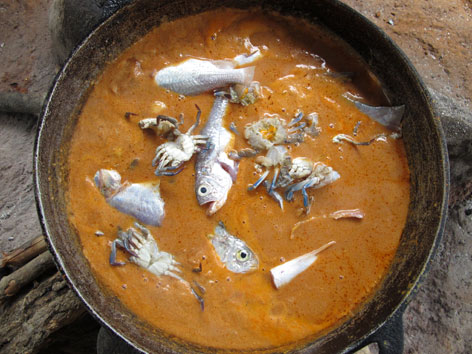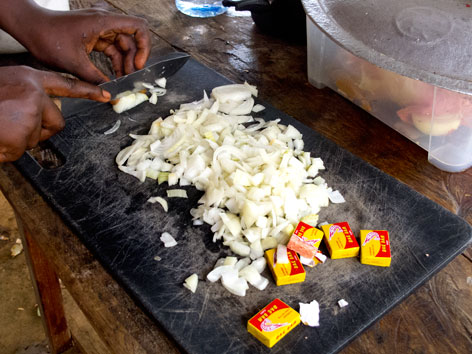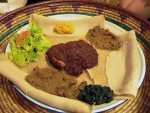Maggi stock cubes—rich with sodium, MSG, and hydrogenated fats—are ubiquitous in West African cooking. Meet the nutritious traditional seasonings they’re replacing.

Groundnut soup, Sierra Leone
At a beautiful eco-resort on Sierra Leone’s Freetown Peninsula this spring, Scott and I were invited to tag along for the weekly run to the local market. On the shopping list was everything from groundnuts (peanuts) and pineapple to bread and eggs, and Maggi. I didn’t think anything of the flavoring agent, figuring the stock cubes were thrown into a few of the local stews as a base. But a large pack was purchased for the week, and at the market, it was clearly a popular item. We soon realized that every dish we ate at this resort incorporated shrimp-flavored bouillon cubes, from the standard potato-leaf stew to the delicious tomato-based “special sauce” that accompanied the fresh grilled lobster.
It didn’t end there. It quickly became evident that most restaurants we visited in Sierra Leone used Maggi (or its Chinese cousin, Dag Bah, made by Qiangwang Group) in their food. On remote Tiwai Island, where the sole cook often had to obtain ingredients from villages off-island, the seasoning was present in every dish. Construction workers who set up a makeshift lunch camp deep in the hills near Kenema put Maggi in the plasa they cooked. In Senegal, too, women selling our favorite dishes outside markets in Dakar cited Maggi as an ingredient. It seemed that, like groundnuts, black-eyed beans, okra, palm oil, rice, and millet, Maggi cubes are just another key component of West African cooking.

Making lunch in Sierra Leone
So what’s the problem?
Maggi cubes are high in not only sodium—similar products average about 1,000mg per cube or half cube—but also hydrogenated oils and monosodium glutamate, or MSG. Excessive sodium, of course, is linked to high blood pressure, which can lead to heart disease, stroke, heart failure, and kidney disease. Hydrogenated oils (think margarine) are once-healthy oils processed into poisonous trans fatty acids, which have been shown to increase LDL, or “bad,” cholesterol, and decrease HDL, or “good,” cholesterol. And while the jury is still out on MSG—it is “generally recognized as safe” by the FDA in the U.S., and only a relatively small number of people react to it negatively (headaches, nausea, dizziness, etc.)—it’s likely not the sort of thing you want to be in the habit of knowingly eating multiple times a day, every day.
(Nestlé, which acquired the Swiss-owned Maggi in 1947, states on its website that there’s “no consistent clinical evidence to support a food intolerance to MSG” and it’s “safe for general consumption at the current levels.”)
Maggi vs. Tradition
When I realized I was eating this stuff at every meal in West Africa, I immediately heard those bad-for-your-health bells going off, but then another question sprung to mind: How on earth did people here prepare their traditional dishes before Maggi came along?
I did not find my answer in Africa. But back in New York, I noticed in a Sierra Leonean cookbook purchased in Freetown—What’s Cooking Today, by Muriel Emekunle Davies—that while Maggi cubes are often listed as ingredients, they’re always an alternative to something called “ogeri,” which a Freetown chef informed me, via email, is fermented benni (sesame) seeds. Further research identified another traditional seasoning called sounbareh, the seeds of the néré tree, or African locust bean tree, which goes by the name soumbala in other West African countries.
Apparently, sounbareh acts as a thickener, flavoring agent, and meat substitute, and boasts a much higher nutritional value than stock cubes. According to a report from Slow Food and the U.N.’s Food and Agriculture Organization, one reason it’s fallen out of favor is deforestation. Another is that in the marketplace, sounbareh now competes with Maggi.
Several factors negatively affect the availability and consumption of the locust beans: indiscriminate harvesting and burning of the trees, increasing demand for the product from all ethnic groups and pressure from local fauna on the plant—monkeys and squirrels compete with the human population to eat the fruit, especially before they dry out...It is an essential product to local Sierra Leonean gastronomy, and is under pressure from various sources. Some of this pressure is contradictory as on the one hand the demand for the product is high among rural populations, but the availability of the plant is in decline, while on the other the urban or semi-urban populations tend to replace it with Maggi cubes. The processing of the seasoning is part of the Mandingo culture and its spread among other ethnic groups is a factor in social cohesion. The product, particularly when compared with the ubiquitous industrial stock cubes, has a significant nutritional content.
It’s not hard to guess why an urban consumer might choose Maggi over sounbareh for that tasty umami oomph: Preparing the seasoning—a process that includes harvesting, cleaning, fermenting, boiling, and drying the seeds over a course of several days, and then roasting and pounding them for use in cooking—requires plenty more effort and time than simply unwrapping a Maggi cube and dropping it into a stock pot.
By offering a convenient, tasty alternative to traditional methods, Nestlé’s Maggi and its assorted knockoffs, it seems, are providing a handy way to decrease Africans’ nutritional intake and increase their consumption of unhealthy stuff, all the while delivering the knockout blow of threatening their gastronomic traditions and food sovereignty.
.jpg)
A restaurant in Popenguine, Senegal
What can be substituted for Maggi?
When Scott and I alerted the then volunteer manager of the Sierra Leone eco-resort to the inclusion of MSG in every meal, he was alarmed and asked to brainstorm substitutes. We’re not nutritionists or chefs, but one obvious solution was to make homemade stock, perhaps with all those lobster shells they were composting after meals. However, with limited solar power and a tiny refrigerator, the resort wasn’t prepared for such an undertaking just yet.
In Freetown, we met one chef, at a wonderful restaurant called Balmaya, who told us she preferred to use regular old salt and pepper instead of Maggi, which she suspected to be unhealthy. (We can confirm that her food, like this cassava-leaf plasa, was delicious even without it.) MSG the flavor enhancer was born of dried kombu seaweed in Japan—and we’ve heard of chefs in Chinese cooking who use sea kelp in lieu of the stuff—so certainly that could work too.
Of course, once I read about ogeri and sounbareh, those became the clear answers. But are they still used at all? The Freetown chef says yes, especially where Maggi is too expensive for people to afford it (though she notes that production of ogeri has declined dramatically in Sierra Leone, and sounbareh has likewise grown pricey). The Sierra Leonean manager of the eco-resort we visited informs me that ogeri is still used in many traditional recipes, but, echoing the Slow Food report, mostly upcountry. In an email he also alluded to another delicious Maggi substitute made from lati fish, a type of native herring, and added that the resort has dramatically cut back on its Maggi use in the past few months.
Failing natural solutions, it would be up to Nestlé to make a difference, to rework the Maggi formula so it does less potential health damage to the African populace. In March 2012 the company announced plans to fortify its bouillon cubes with iron to address deficiencies in the African market. Which only makes us wonder: Will the added iron be listed before or after the hydrogenated oil and MSG in the ingredient list?










.jpg)

